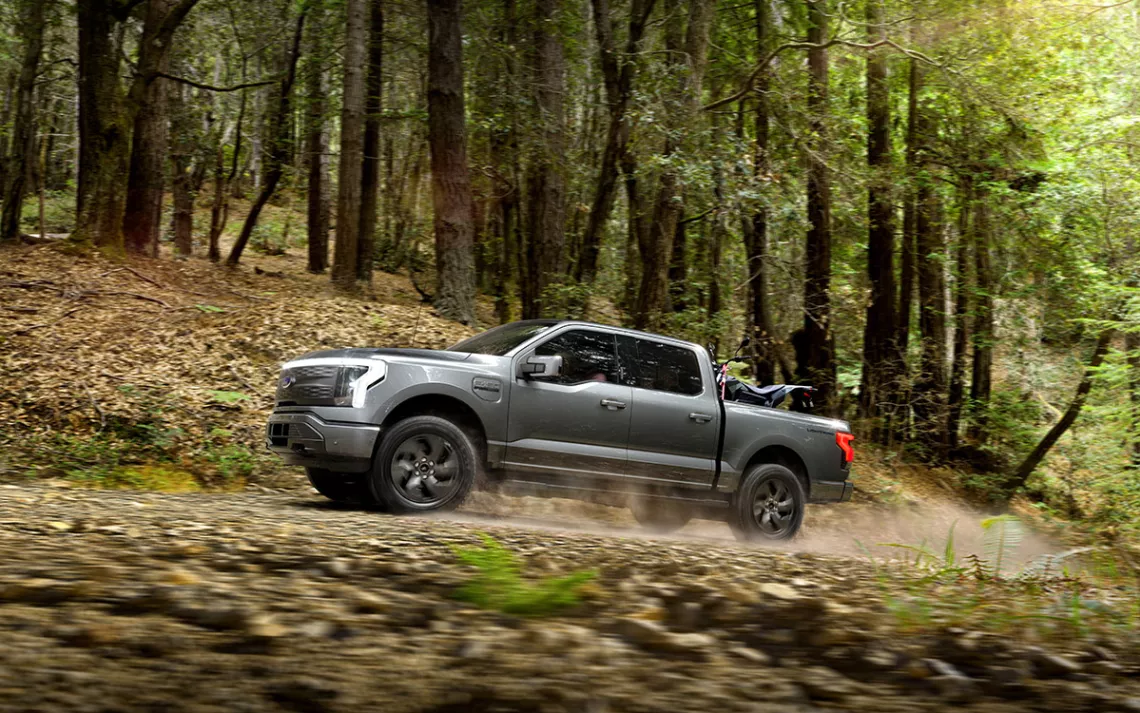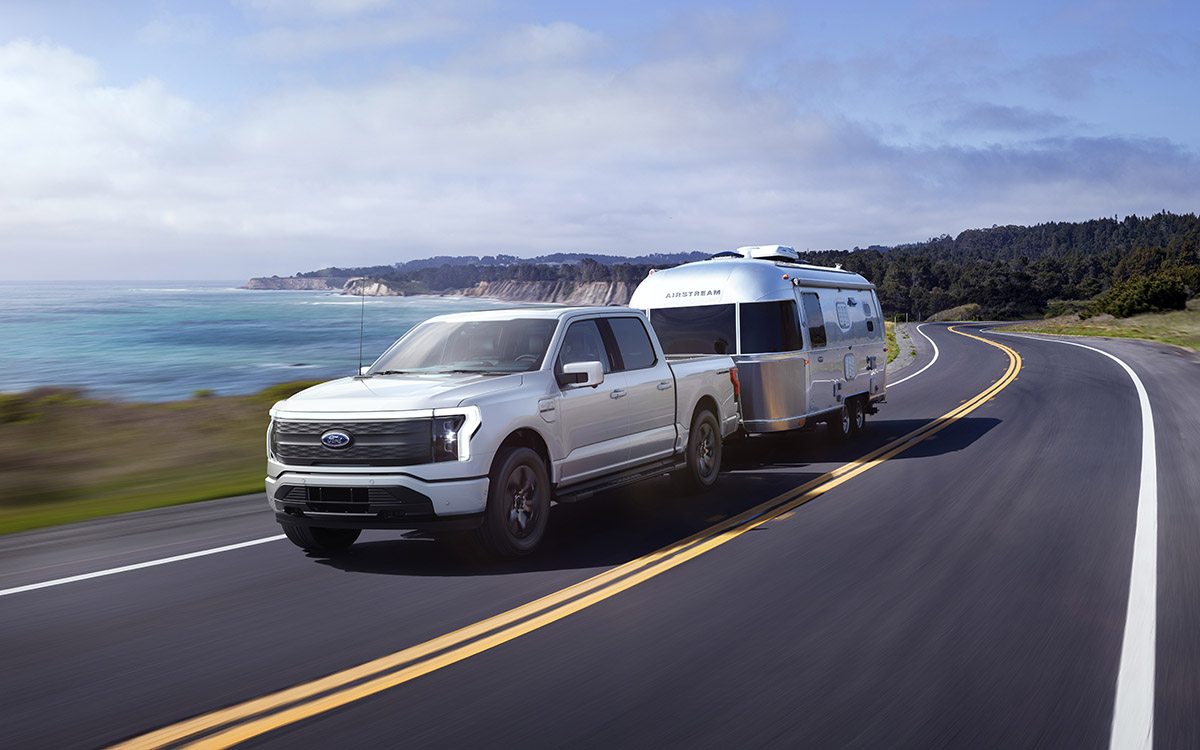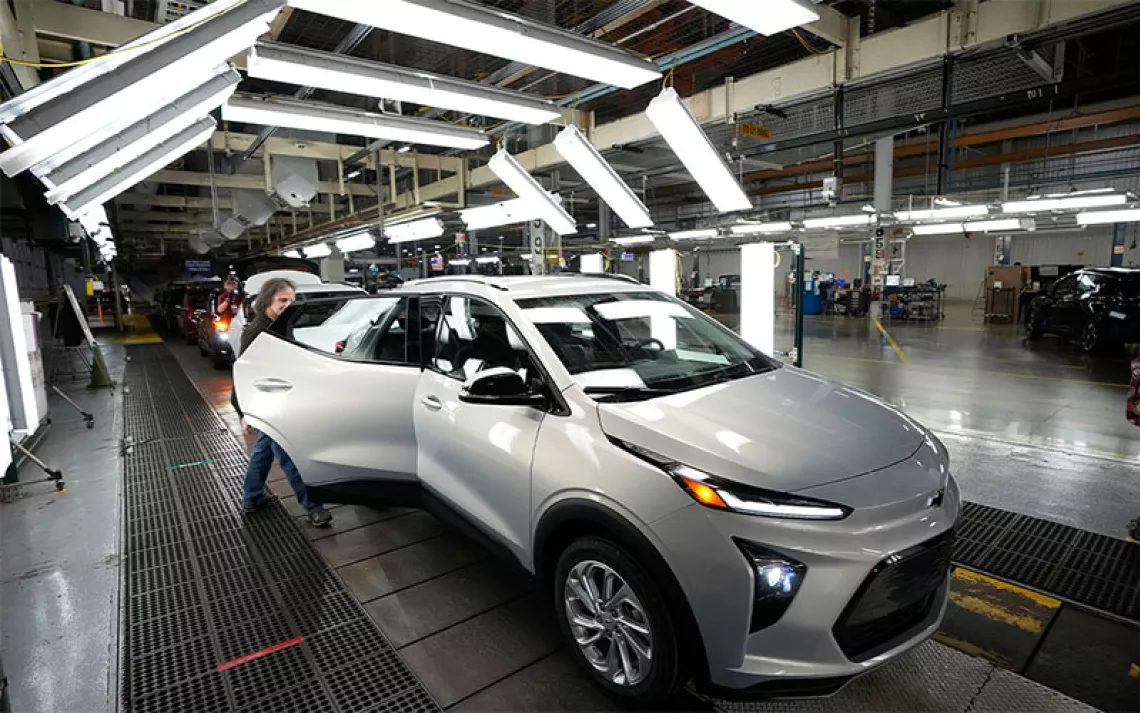Lightning in a Bottle?
Ford’s F-150 EV promises to be a big jolt for electrification

Photos courtesy of Ford
Ford needed a home run with the F-150 Lightning, the first mass-market all-electric pickup truck. When it unveiled the vehicle last week, the automaker hit at least a double, maybe a triple. In any case, the company’s much-heralded announcement seems to have accomplished its goal: With this all-American model, Ford may have permanently altered the public perception of electric vehicles.
In a glitzy unveiling helmed by executive chairman Bill Ford on May 19, the company went heavy on the legacy of innovation and focused on the venerable Rouge plant in Dearborn, Michigan, where the new plug-in truck will be built. Frankly, where the truck will be screwed together matters less than the specs and the price point. The gas-powered F-150 has been America’s best-selling vehicle for 44 years (with 900,000 sold annually), and Ford—along with an enthusiastic Biden administration—is clearly betting on the iconic F-150’s unmatched popularity to bring EVs to the American mainstream. But, as many automotive analysts warned in the weeks leading up to Ford’s official announcement, even the F-150’s cachet won’t be enough to guarantee sales of the electric version. An expensive truck with short range wouldn’t move the needle on plug-in electrification, now at only 2 percent of US sales.
The Ford Lightning has nipped both the concerns about range and price. What Ford called “the smartest, cleanest F-150 ever” will be a tough act to follow. The key metric is the $39,974 price of entry, for a base four-door SuperCrew model with 230 miles of range. That compares to the gas version of the SuperCrew, which starts at $36,650. The deal is actually better than that, because the Lightning is eligible for a full $7,500 federal tax credit, plus whatever state or local incentives apply to EVs. This highly competitive price left observers agape.
The reason we’re talking about second and third base instead of home plate is that the extended-range version with 300 miles of range starts in the mid-$50,000s. But sticker shock probably won’t be an issue for the pool of current for F-150 buyers, who regularly scarf up Limited, King Ranch, and Raptor versions with MSRP in that ballpark or higher.
Buyers who haven’t previously considered an electric truck are going to find a lot to like. So too will longtime truck buyers, who will be enticed by the price point, the standard features, and—especially—the vehicle’s ability to do the hard work of a standard pickup. The Lightning can tow 10,000 pounds and carry a 2,000-pound payload. And it “hauls ass,” as Jim Farley, Ford president and CEO put it, with twin motors for all-wheel drive and, in some versions, a mid-four-second zero to 60 time, a targeted 563 horsepower and the most torque of any F-150, 775 pound-feet. It also should be a good performer on unmaintained roads, with an Off-Road mode and metal skid plates to protect the battery and inboard electric motors from obstacles.
On paper, the truck looks good. But even though they may say they’re open-minded, are pickup people really primed to buy electric? For now, at least, the answer appears to be probably not—if only because plugging in to fuel up still seems like a big leap for many drivers. Ford really needs to go into overdrive to sell the many advantages of this truck. A Consumer Reports survey last year found that only 30 percent of respondents knew much about EVs. But some drivers are prepared to be open-minded, which is key. A 2021 Cox Automotive poll found that 40 percent of likely truck buyers would consider buying an EV pickup.

The baseball metaphors continue from the analysts. According to Michelle Krebs, director of automotive relations at Autotrader.com, “If someone can really buy one for $40,000, the truck may well be a home run. Three obstacles to EV adoption, according to studies, are price, range, and charging infrastructure.” This vehicle clearly checks off at least the first two.
And says Sam Abuelsamid, principal analyst at Guidehouse Insights in Detroit, “I think this truck is going to be a big hit for Ford. They’ve priced it very aggressively, and it has some really cool features. Most of all, it's a truck-shaped truck that does the truck stuff that truck buyers expect.”
The cool stuff Abuelsamid cites includes a very large under-hood “frunk” for storage that is made possible by the absence of a big lump of internal combustion. The Lightning also boasts up to 9.6 kilowatts of “Intelligent Backup Power” that can bring electricity to work sites and even homes during an outage (for up to three days). There’s also an available onboard scale to weigh the payload, the ability to use your phone as the key, a 15.5-inch touchscreen with digital instrumentation, and, in that cool frunk, several electrical outlets for power tools.
And what about that third item of Krebs’s list of EV deal-killers—drivers’ concerns about charging infrastructure? Ford says it can address that challenge by giving its drivers access to 63,000 charging plugs nationwide. The specifics of that will be interesting to watch develop, especially when compared with Tesla’s very effective global charging network. The extended-range version of the Lightning with DC fast charging can add 54 miles of range in 10 minutes, and go from a 15 to an 80 percent state of charge in 41 minutes.
Ford didn’t say how big the battery packs are in these trucks, but given the weight to be moved and the range given, one guess is around 110 and 150 kilowatt-hours. That’s big, and undoubtedly expensive to build. Which means the company probably won’t make much money selling the Lightning, at least initially. But as Toyota proved with the Prius—which was a loss leader for years—that early entry is a major bonus. Toyota still owns the bulk of the hybrid market. Tesla is another example of how being a market pioneer can pay off. Tesla got in early with upscale, performance EVs; despite Elon Musk’s many naysayers, Tesla today dominates the market for high-end EVs.
Ford will need that head start, because the company’s rearview mirror is already filling up with competitors. While there are currently no electric pickups on the US market, credible entries are on the way from Bollinger, Rivian, General Motors, Lordstown, and Tesla. Still, the F-150 Lightning will be tough to beat. GM’s forthcoming Hummer EV SUT electric pickup has many attributes, but a low price isn’t one of them. Even the base model will sell for $80,000. An electric Silverado is coming, and maybe that will be easier on the wallet.
Let’s hope so, because the bottom line when it comes to actually moving the gas-guzzling truck market is, well, the bottom line itself.
 The Magazine of The Sierra Club
The Magazine of The Sierra Club







